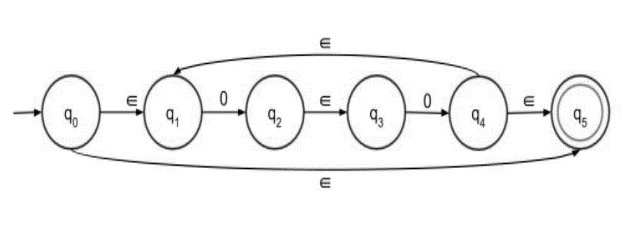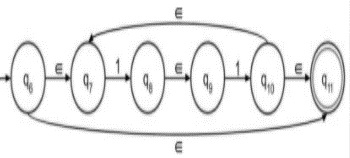
 Data Structure
Data Structure Networking
Networking RDBMS
RDBMS Operating System
Operating System Java
Java MS Excel
MS Excel iOS
iOS HTML
HTML CSS
CSS Android
Android Python
Python C Programming
C Programming C++
C++ C#
C# MongoDB
MongoDB MySQL
MySQL Javascript
Javascript PHP
PHP
- Selected Reading
- UPSC IAS Exams Notes
- Developer's Best Practices
- Questions and Answers
- Effective Resume Writing
- HR Interview Questions
- Computer Glossary
- Who is Who
Construct ∈-NFA of Regular Language L = (00)*1(11)*
The ε transitions in Non-deterministic finite automata (NFA) are used to move from one state to another without having any symbol from the input set Σ.
ε-NFA is defined in five tuple representation
{Q, q0, Σ, δ, F}
Where,
δ − Q × (Σ∪ε)→2Q
Q − Finite set of states
Σ − Finite set of the input symbol
q0 − Initial state
F − Final state
δ − Transition function
NFA without ε transition
NFA also has five states same as DFA, but with different transition function, as shown follows −
$$\delta\colon\:Q\times\:\sum\longrightarrow\:2^{Q}$$
Where,
Q: Finite set of states
Σ: Finite set of the input symbol
- q0: Initial state
F: Final state
δ: Transition function
Let’s consider the given language L = (00)*1(11)*.
The given language is divided into three parts (00)*, 1 and (11)*. Let’s construct the transition diagram for each part and finally concatenate the three parts to get the final result.
Step 1 − NFA with epsilon for (00)* is as follows −

Step 2 − NFA with epsilon for (11)* is as follows −

Step 3 − Concatenate first and second part with 1 in between, as follows −


